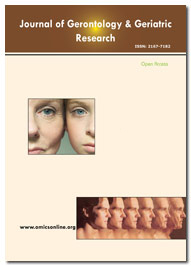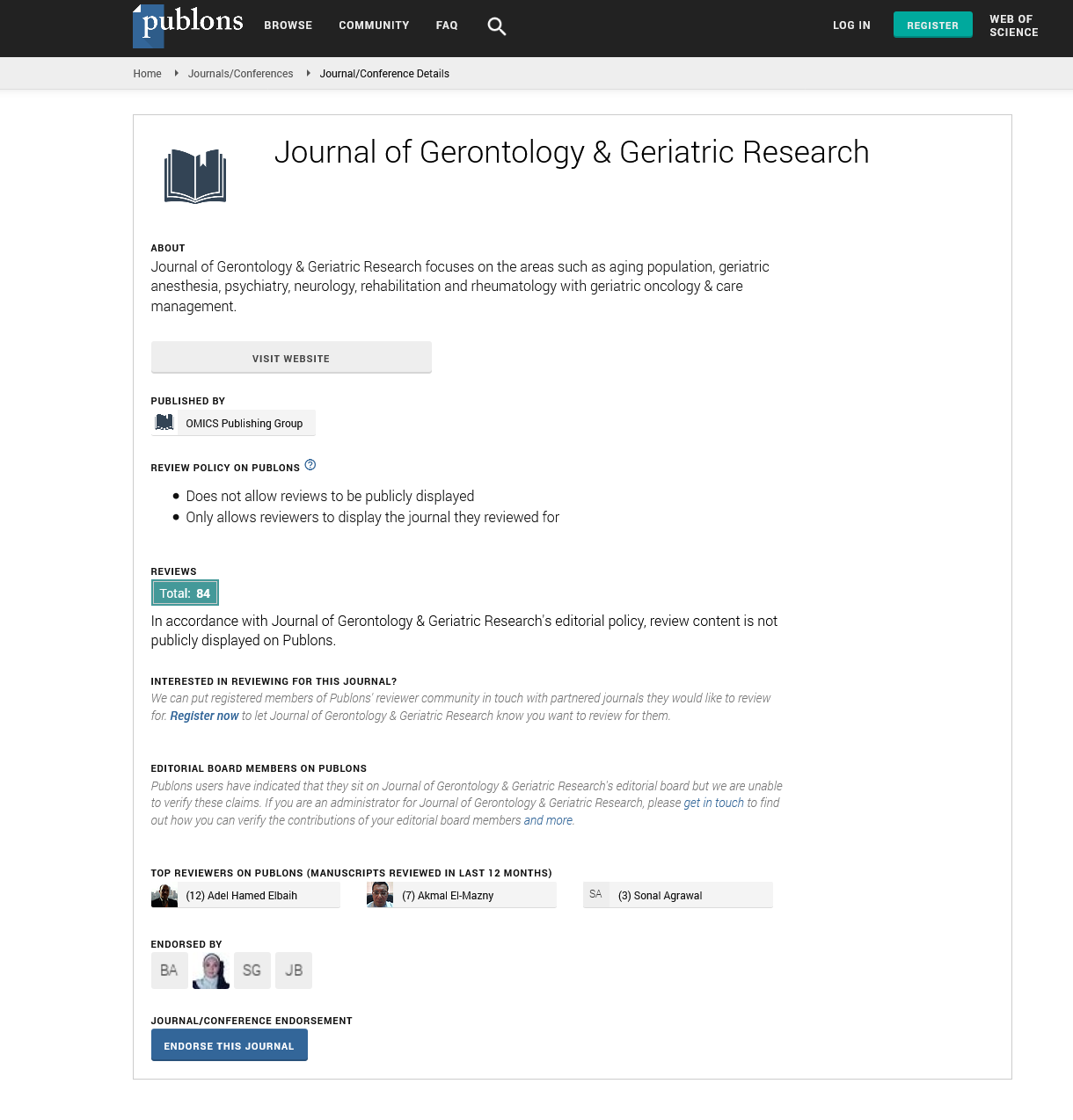Indexed In
- Open J Gate
- Genamics JournalSeek
- SafetyLit
- RefSeek
- Hamdard University
- EBSCO A-Z
- OCLC- WorldCat
- Publons
- Geneva Foundation for Medical Education and Research
- Euro Pub
- Google Scholar
Useful Links
Share This Page
Journal Flyer

Open Access Journals
- Agri and Aquaculture
- Biochemistry
- Bioinformatics & Systems Biology
- Business & Management
- Chemistry
- Clinical Sciences
- Engineering
- Food & Nutrition
- General Science
- Genetics & Molecular Biology
- Immunology & Microbiology
- Medical Sciences
- Neuroscience & Psychology
- Nursing & Health Care
- Pharmaceutical Sciences
Commentary - (2024) Volume 13, Issue 5
Exploring the Role of Nutrition in Aging: A Comprehensive Review for Geriatric Practice
Udatri Shye*Received: 02-Oct-2024, Manuscript No. jggr-24-27664; Editor assigned: 04-Oct-2024, Pre QC No. P-27664; Reviewed: 17-Oct-2024, QC No. Q-27664; Revised: 23-Oct-2024, Manuscript No. R-27664; Published: 30-Oct-2024, DOI: 10.35248/2167-7182.2024.13.754
Introduction
Aging is a complex, multifactorial process that encompasses biological, psychological, and social changes. As the global population continues to age, there is an increasing need to address the health and well-being of older adults. Nutrition plays a crucial role in healthy aging, influencing the development and management of chronic diseases, the preservation of functional independence, and the overall quality of life for elderly individuals. However, older adults often face unique nutritional challenges that complicate their dietary needs, including changes in metabolism, decreased appetite, limited access to nutritious foods, and age-related conditions such as dysphagia or dental problems. This review seeks to explore the profound impact of nutrition on aging, specifically examining how dietary habits and nutrition interventions can enhance geriatric care. By understanding the nutritional needs and risks associated with aging, healthcare providers, caregivers, and policymakers can work together to improve the nutritional status and health outcomes of older adults. This review will cover the role of nutrition in preventing and managing common age-related conditions, including frailty, sarcopenia, cognitive decline, and cardiovascular disease, and provide evidence-based recommendations for integrating nutritional strategies into geriatric practice .
Description
Nutrition is one of the most modifiable factors affecting aging. The body’s ability to maintain muscle mass, bone density, immune function, and cognitive health depends heavily on a nutrient-dense, balanced diet. As individuals age, their ability to absorb and utilize nutrients may decline, making them more vulnerable to nutritional deficiencies that contribute to frailty, weakened immune systems, and poor recovery from illness or surgery. Older adults have unique nutritional needs compared to younger populations. For example, as we age, caloric requirements typically decrease, but the need for certain micronutrients, such as vitamin D, calcium, and vitamin B12, may increase [1,2]. At the same time, protein intake becomes more critical for maintaining muscle mass and preventing sarcopenia, the progressive loss of muscle tissue associated with aging.
Chronic conditions, such as heart disease, diabetes, and osteoporosis, are more prevalent in older adults and can be directly influenced by dietary patterns. For example, a high-sodium diet can exacerbate hypertension, while insufficient calcium and vitamin D intake can accelerate bone loss and increase fracture risk [3]. By optimizing nutrition, it is possible to manage or even mitigate the effects of these conditions, improving both quality of life and longevity. One of the most significant aspects of nutrition in aging is its role in preventing sarcopenia, a condition that significantly impacts mobility, independence, and overall well-being. Protein is essential for maintaining muscle mass, and ensuring adequate protein intake in the diet can help to mitigate muscle loss [4]. In addition, resistance exercise combined with proper nutrition can further enhance muscle strength and function in older adults.
There is growing evidence that nutrition plays a critical role in preserving cognitive function and preventing age-related cognitive decline, including conditions like Alzheimer’s disease and other forms of dementia. Diets rich in antioxidants, omega-3 fatty acids, and certain micronutrients, such as vitamin E, folate, and magnesium, have been associated with a reduced risk of cognitive decline. Furthermore, the Mediterranean diet, known for its emphasis on fruits, vegetables, whole grains, and healthy fats, has shown promise in promoting brain health. Despite the clear benefits of proper nutrition, older adults often face numerous barriers to maintaining a balanced diet [5]. These can include physical limitations (such as difficulty chewing or swallowing), limited access to fresh foods, financial constraints, and social isolation, all of which can hinder their ability to consume adequate, nutritious meals. Healthcare professionals and caregivers must be aware of these challenges and develop strategies to support older adults in meeting their nutritional needs, such as providing assistance with meal preparation, offering supplements where necessary, and encouraging social dining opportunities.
Conclusion
Nutrition is a cornerstone of successful aging, playing a pivotal role in preventing or managing chronic diseases, preserving functional independence, and improving quality of life. As the population of older adults continues to rise, it is increasingly important for healthcare professionals, especially those involved in geriatric care, to recognize the importance of nutrition in aging and to adopt a comprehensive, individualized approach to dietary assessment and intervention. This review underscores the multifaceted role of nutrition in aging, from muscle health and cognitive function to chronic disease management and overall well-being. By identifying and addressing the unique nutritional needs and challenges faced by older adults, healthcare providers can significantly improve health outcomes and reduce the burden of age-related diseases. As we move forward, it is essential that nutrition be integrated into geriatric care not only as a supportive therapy but as a proactive strategy for promoting healthy aging.
Acknowledgement
None.
Conflict of Interest
None.
References
- Lord SR, Dayhew J. Visual risk factors for falls in older people. J Am Geriatr Soc. 2001;49:508-515.
- Hou CH, Pu C. Association between visual impairment and health care use. Am J Ophthalmol. 2022;234:166-173.
- Cicinelli MV, Buchan JC, Nicholson M, Varadaraj V, Khanna RC. Cataracts. Lancet. 2023;401:377-389.
- Takefuji Y. Frailty and eye diseases: A review of the literature. Eye. 2024;38:648.
- Lim LS, Mitchell P, Seddon JM, Holz FG, Wong TY. Age-related macular degeneration. Lancet. 2012;379:1728-1738.
Google Scholar, Crossref, Indexed at
Google Scholar, Crossref, Indexed at
Google Scholar, Crossref, Indexed at
Google Scholar, Crossref, Indexed at
Citation: Shye U (2024). Exploring the Role of Nutrition in Aging: A Comprehensive Review for Geriatric Practice. J Gerontol Geriatr Res. 13: 754.
Copyright: © 2024 Shye U. This is an open-access article distributed under the terms of the Creative Commons Attribution License, which permits unrestricted use, distribution, and reproduction in any medium, provided the original author and source are credited.

